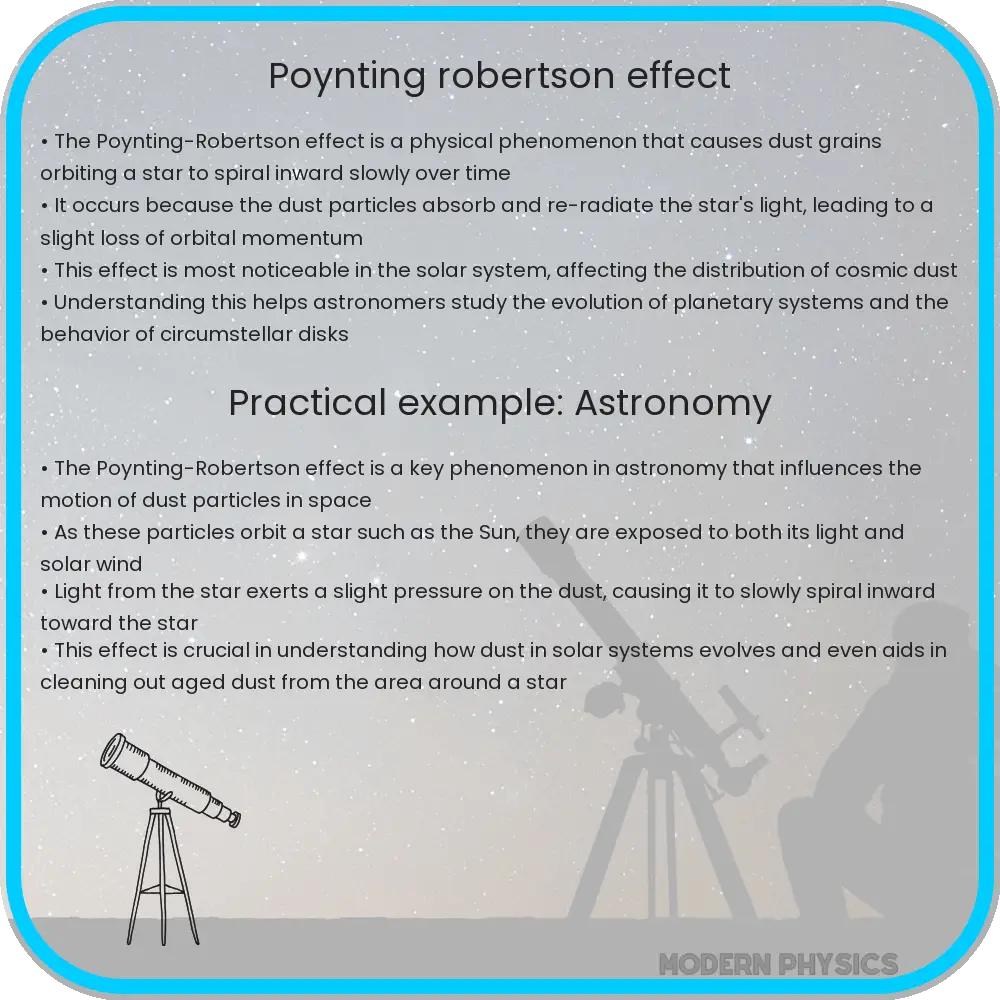Explore the Poynting-Robertson Effect’s role in astrophysics, its impact on solar system dust, and its significance in cosmic evolution.

Understanding the Poynting-Robertson Effect: Solar Radiation, Momentum, and Drag
The Poynting-Robertson Effect is a fascinating phenomenon in astrophysics that explains how solar radiation impacts the orbit of dust particles in the solar system. This effect, a subtle blend of physics and astronomy, offers insights into the behavior of cosmic dust particles under the influence of the Sun’s radiation. The effect is named after British physicist John Henry Poynting and American astronomer Howard Percy Robertson, who contributed significantly to its understanding.
The Basics of Solar Radiation and Momentum Transfer
Solar radiation, primarily composed of photons, carries both energy and momentum. When these photons strike a surface, like that of a dust particle in space, they transfer momentum to it. This transfer primarily causes two effects: radiation pressure and the Poynting-Robertson drag.
Radiation pressure acts like a solar wind, pushing particles directly away from the Sun. However, the Poynting-Robertson effect is more nuanced. It results from the combination of the radiation pressure and the orbital motion of the dust particles around the Sun.
How the Poynting-Robertson Effect Works
Imagine a dust particle orbiting the Sun. As it absorbs solar radiation, it re-emits this energy in all directions. Due to its orbital velocity, the re-emitted radiation is not symmetrical; there’s a slight forward bias in the direction of its motion. This asymmetry causes a drag force, opposing the particle’s motion. This drag is known as the Poynting-Robertson effect.
The consequence of this drag is significant for the particle’s orbit. Over time, it loses angular momentum, causing a gradual spiral inward towards the Sun. This effect is especially noticeable in small particles, such as cosmic dust, because of their lower mass and higher surface area-to-mass ratio.
Implications in Astrophysics and Planetary Science
The Poynting-Robertson effect plays a crucial role in shaping the solar system’s evolution. It helps in clearing out the debris and dust from the region near the Sun, influencing the formation and maintenance of planetary rings and the structure of the zodiacal dust cloud. Understanding this effect is vital for interpreting observations of dusty circumstellar disks around other stars and for planning spacecraft missions through dusty environments.
Moreover, this effect has implications for the study of meteoroids, comets, and asteroids. By altering the orbits of these small bodies, the Poynting-Robertson effect can change their potential paths, including those that might intersect with Earth.
Modeling and Quantifying the Poynting-Robertson Effect
To quantify the Poynting-Robertson effect, astronomers and physicists use mathematical models that consider various factors, such as the particle’s size, shape, and reflective properties. The intensity of solar radiation, the distance from the Sun, and the particle’s velocity also play crucial roles. The effect is generally more pronounced on smaller particles, as their surface area-to-mass ratio is higher, making them more susceptible to radiation forces.
Research and Observational Studies
Research into the Poynting-Robertson effect has been bolstered by observational studies of the solar system and beyond. Space missions, such as the Hubble Space Telescope and various interplanetary probes, have provided valuable data. Observations of comet tails, asteroid belts, and interstellar dust also offer practical insights into the mechanics of this effect.
Challenges and Future Prospects
Despite its apparent simplicity, accurately modeling the Poynting-Robertson effect is challenging. The complexity arises from the need to consider various physical processes, such as the interaction of light with irregularly shaped and compositionally diverse particles. As technology advances, more sophisticated simulations and deeper space missions could provide a clearer understanding of this effect and its influence on celestial mechanics.
Conclusion
The Poynting-Robertson effect is a subtle yet critical phenomenon that influences the motion and behavior of dust particles in the solar system. It exemplifies the intricate ways in which light and matter interact in space, leading to significant implications for astrophysics and planetary science. This effect not only aids in our understanding of the solar system’s evolution but also plays a role in shaping the cosmic environment. Future research, enhanced by technological advancements, promises to deepen our comprehension of this phenomenon, potentially unveiling new aspects of cosmic dust dynamics and contributing to our broader understanding of the universe.
